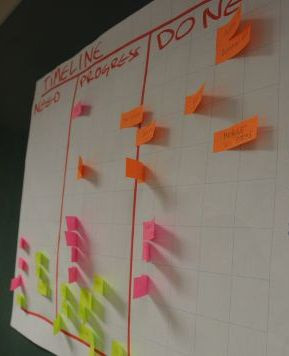As many of you might know, Qminder started at a weekend hackathon Garage48. What is Qminder? Simply put: it's a queue management system.
Since the is taking place this weekend and we are getting more and more pings and questions about our
experience, we offer a quick overview of Qminder’s first 48h and hopefully some useful tips:
Briefly on the concept of Garage48:
Garage48 events usually start at 5pm on a Friday evening. All
participants gather together in a big room and pitch about 30 to 40
ideas on stage. Each idea is put on the wall and everyone can choose
their favorite idea and team. Usually, about 12-15 ideas will be
selected and teams start working.
Friday
…or even before Friday - Do your homework! - although a common guideline for these kinds of events suggests that no work should be done beforehand.
The Garage48 ideas are posted in the participants’ Facebook group,listed, tweeted and presented in some form before the event. Getting
familiar with these ideas is not cheating, but rather common sense to
speed up the process on-site, in order to find the best suitable idea
for you. Because the way the teams are formed can only be described with
the word ‘chaos’.
When you are pitching and trying to attract talent – it gets even
harder. Not to get into the intricacies about the art of pitching,
suffice it to say that you have to make sure it’s clear visual and
offers information on who you are looking for and what you hope to
establish in 48h.
This was exactly the case with Qminder:
Our design and concept author Markko Karu listed the idea and thus made
it a no-brainer for me, Rauno Rüngas, to approach him before the event
started, as I had had a similar idea written down a few months prior to
the event. This glimpse of mutual vision helped us gain confidence and
form the team more quickly. And again on the subject of preparation:
Markko’s one-pager in its visual glory was miles ahead of the pitches
that consisted of “here is the word document – read it”.

Don’t hold back on forming the teams! Furthermore, you need to make sure
that there are enough people in your team to handle the different sides
of the project. It may vary according to your goals – depending on
whether you want to start a business, have fun, challenge yourself or
just find that one person who is willing to work with you .
But you have to take into account that even the brightest idea and the
most elegant code will fade fast, if it has no face or it is not backed
by someone who can communicate it all to the audience.
Pro-tip: There is no shame in targeting your initial 48h prototype to
the direction of sponsor prizes.
In our case, it was the Nokia Prize. To win a couple of development
phones, we had to ship something on the Nokia Meego platform. We did
exactly that and won the phones, regardless of it having a low
groundwork value for the future development and platform. It still
provided us with a solid prize for further motivation, a fast reward for
the developers and having a smart and hands-on sponsor representative
close during the whole time. Most of all, the developer who we recruited
last, “who had done something on Qt/Nokia platform 7 years ago” and was
willing to “give it a try”, wound up being one of the most valuable
assets – our CTO Siim Raud.
Once you get working: if possible, sit behind one table! As many of
these events are held in auditoriums and classrooms, don’t fear to mess
around and quickly form a conference table.
**
Pro-tip: leave a chair empty, door open, pathway seen to project
manager/marketing guy, so that people can visit you. They could be
organizers, mentors, journalists, event sponsors or whoever. This can be
summed up into the simple fact of keeping an open mind-set, keeping the
dialogue going and being available to spontaneous others.
A big part of Friday will be planning, but that does not mean that you
have to decide the platforms, frameworks, the name, domain etc. then and
there.
Brainstorm, and if something is left undecided, just mark the deadline
for the next morning at 10:00.
Pro-tip: Getting everybody under the same roof definitively helps bond
the team. So, if you have floor space in the same city where the event
is held, be ready to take in nomad team members. Aside from making sure
nobody sleeps in after a long night, it speeds up the process of
continuing where things were left off the previous evening.
Saturday

Make no mistake – you do not have 48 hours! You have Friday for
preparation and Sunday for finishing up and polishing – to get something
done, you actually only have the one Saturday!
By noon, the plan has to be almost solid, so that everybody could focus
on their work and get into the zone, get wired in, be in the moment or
whichever term suits best – everybody has one. This is the time to be on
the top of your game.
For the project manager, it means a clear plan and following it, for
coders and designers, it means focusing on the creative effort, for the
ones responsible for marketing, it means calling/going to potential
customers and partners.
In our case, it meant hustling people on the last weekend of the summer
– demonstrating that there are no excuses to be made on the customer
development part! Validating the idea and preparing for the future is
just part of that – in 48h having that extra confirmation and validation
on Saturday evening to motivate a tired and a newly formed team is
priceless!

Tip: Use whatever resources you have. Your job is to make it happen in
48 hours. That is difficult. That is what great men have taught for
ages:
“All is fair in love, war and Garage48″. For Qminder, it meant forcing
a friend to pick-up the machinery from a potential partner we had
called, and to drive 2o0km to Tartu, where the event was held.
Pro-tip: If as a project manager/marketer you want to motivate the
developers to give all they have on that Saturday evening , you’d better
know what time the nearest pizza place closes, deliver it, leave them
alone to not over-manage and hope for the best.
Tip: If you are the guy having to pitch the next day, maybe give an
interview, talk to customers, mentors etc. – get some sleep, you don’t
have the privilege to be grumpy, tired, smelly or anything the like on
the next day.
Sunday
By Sunday morning, the product will most likely not be ready, your
vision on the other hand had better be ready. You have to know what you
are going to pitch, what is the plan for the day, the coming weeks etc.
This will all change anyway, but while talking to visitors, mentors, or
judges on the last day, you have to have a plan – they cannot help,
advise or comment, if you don’t have the plan. We are now talking about
the plan that is the mix of the naive vision you had on Friday, the
harsh reality you experienced on Saturday (both tech, bizdev and
custdev), and a plan that has to win the hackathon and keep the team
together even after they go back to their daily jobs on Monday.
On the last day, the project manager really has to step in, evaluate
what has been done, what can be done in the last hours and how to gain
the maximum out of all the options. To get a working demo for example.
To see what he or she can pitch on the stage in the evening.
Tip: Don’t change the pitch at the last minute. You might have gotten
some great new idea, but changing a pitch that you are doing for the
first time at the last minute, will most likely mess everything up.
Unfortunately, this was the case with Qminder. A pitch within the
time-limit was completely restructured at the last minute and basically
collapsed on stage.
…But it didn’t matter:
Pro-tip: Don’t worry about the pitch – DEMO! Show the progress, show
what you did, communicate how the customer reacted and what the partners
said. Nobody is taking your short pitch word by word giving information
about the made-up numbers, about the market size and what you THINK
customers need. Surely after 48 hours you can’t know that (even if it is
true, they will not be convinced). The only thing that matters is a
working demo with every validation point you can get your hands on: a
customer testimony, letter of intent or partnership.
Be sure to have a webpage up with a clear call-to-action and conversion
plan. The hype and traffic you get will most likely be the high point
for many weeks or months.
For Qminder, the primitive webpage with a couple of screenshots and
e-mail collection fields was the only thing visible for the outside
world for almost 4 months.
Good thing we had great designer on board who created it, because the
prototype you ship within 48h will most likely suck pretty badly and
will not be operable anyway, so all you have is the design. The design
of the plan and the design of the webpage.

Tip: Help others! Although this might contradict the strict “All is
fair in love, war and Garage48″ postulate, don’t forget that this
weekend is also about networking and proving with hundreds of other
people, that times have changed and shipping something within 48h is
possible. The benefits of having connections and helping others should
in general be clear to everyone anyway.
How to win a hackathon,
how to get the maximum out of the weekend,
how to connect,
how to form a team,
how to pitch,
these are all subjects demanding discussion and experience-sharing.

… in the end it just comes down to #JFDI
Just F Do It!



